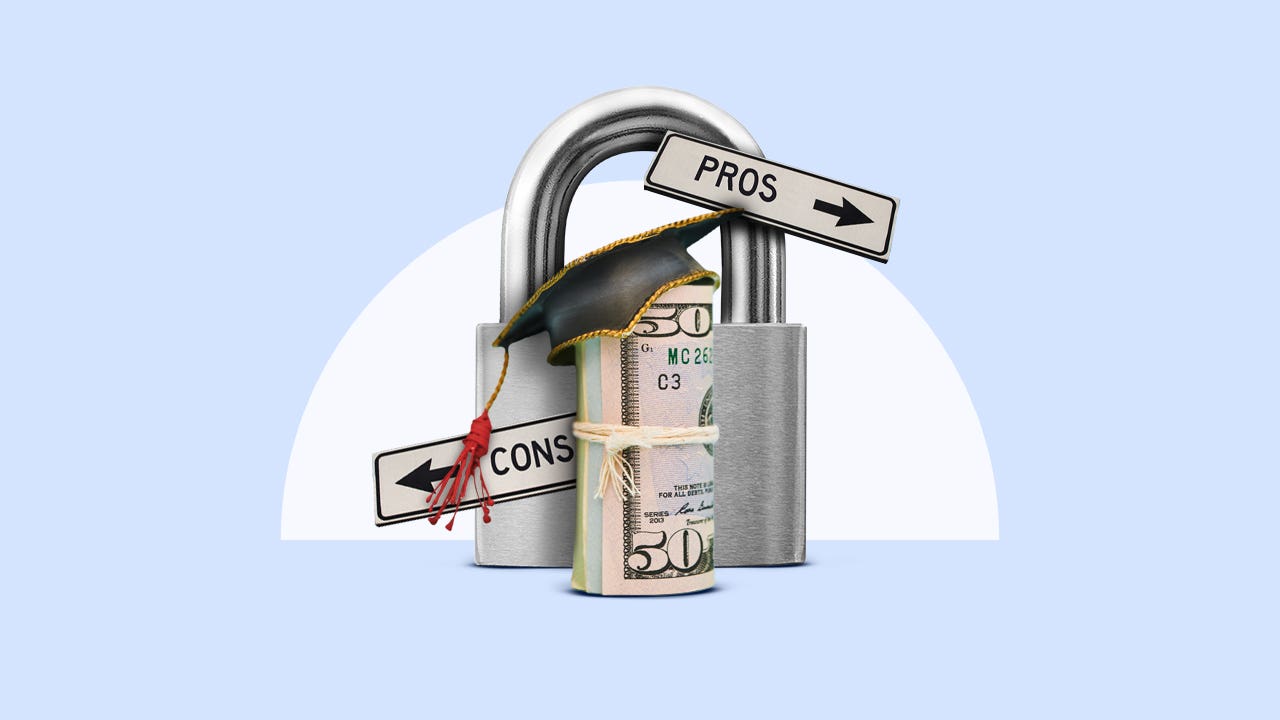Pros and cons of private student loans

The Bankrate promise
At Bankrate we strive to help you make smarter financial decisions. While we adhere to strict , this post may contain references to products from our partners. Here's an explanation for .
Key takeaways
- Private student loans may offer higher borrowing limits and potentially lower interest rates compared to federal loans.
- Private student loans may also be tax deductible, but they can carry the risk of not being discharged in bankruptcy and potentially persisting after death.
- Private student loans do not offer the same benefits as federal loans, such as income-driven repayment plans and loan forgiveness options.
- The application process for private student loans is typically faster, but it's important to carefully consider the terms and potential risks before borrowing.
Private student loans can be a viable option if you’ve exhausted your allotment of federal loans and other free funding sources. That’s because these types of student loans come with higher loan limits, and the borrowing costs are sometimes lower compared to their federal counterparts.
That said, private student loans aren’t without limitations. For example, you won’t get access to income-driven repayment plans, loan forgiveness options (if you’re eligible) and the other benefits that come with federal loans. You could also spend more than you anticipated in interest if you have a lower credit score.
Pros of private student loans
Private student loans can help bridge the gap when federal aid falls short, allowing you to borrow up to your school’s cost of attendance and often provide competitive rates if you have good credit.
Can be cheaper than federal loans
If you’re an undergraduate student, you likely won’t find anything cheaper than a federal student loan, especially if you haven’t had the chance to build a credit history. However, graduate and parent loans through the Department of Education are pricier than undergraduate loans, both with interest rates and the upfront loan fee.
If you have a solid income and a high credit score, you could potentially score a lower interest rate than the federal government charges. Also, private student lenders typically don’t charge an upfront fee.
Depending on the situation, it’s good to compare what you might qualify for with private lenders and what the federal government offers.
Higher borrowing limits
If you’re attending an expensive school, you may not get the amount you need if you only go through the federal government for student loans.
For instance, if you’re an undergraduate student, you can borrow between $5,500 and $12,500 per year, depending on your year in school and dependency status. The lifetime maximum is $31,000 for dependent students and $57,500 for independent students.
With private loans, however, you can typically borrow up to the total cost of attendance, minus any financial aid received, every year, giving you more flexibility to get the financing you need.
Fast application process
You must file the Free Application for Federal Student Aid (FAFSA) to access federal student loans. It typically takes up to an hour to complete and three to five days to process if you submit it online. The processing time for paper applications is seven to 10 business days.
By contrast, most private lenders feature a much more streamlined application process. You can generally apply online, upload requested income documentation and get approved and funded in just a few business days.
Open to those who don’t qualify for federal student loans
Borrowers not eligible for federal student loans may find they qualify to borrow private student loans. This includes students who do not demonstrate financial need, aren’t enrolled at least half-time, are non-citizens without a green card but with a co-signer who is a U.S. citizen or those who have exceeded the maximum federal borrowing limit.
The requirements for private borrowing are different and will likely consider your finances. This may be an especially helpful option if you do not qualify for other types of financial aid.
Potentially tax deductible
Up to $2,500 in private student loan interest each year may be tax deductible on your return. Lenders will issue a form 1098-E indicating how much interest you’ve paid over the previous year. Consult the IRS website or a tax professional for details.
Cons of private student loans
Private student loans can present some potential issues for borrowers, such as limited repayment plans, ineligibility for federal forgiveness programs and fewer relief options during financial hardship. More than that, they also typically require a good credit score or a cosigner.
No access to income-driven repayment or forgiveness
Federal loans offer income-driven repayment plans that reduce payments based on borrowers’ income, a great option for borrowers struggling to meet high monthly payments. Most private lenders don’t extend that same generosity; the only way to lower monthly payments is through refinancing.
Also, if you work as a teacher or in some other form of public service, you may qualify to have some or all of your federal loans forgiven after you meet certain criteria. There are also other forgiveness programs through federal loans.
Private lenders don’t have that option, nor would they be included in any executive action canceling student debt.
Interest rates are based on creditworthiness
In some cases, you can qualify for lower interest rates with private lenders than the federal government offers. However, private lenders offer a range of rates, and unless your income and credit score are stellar, you may end up with a much higher rate than you want.
Of course, many private lenders allow you to apply with a co-signer, such as a parent, which can improve your chances of getting favorable terms. But even that’s no guarantee.
It’s also important to note that the lowest private student loan interest rates are generally variable, fluctuating over time with market conditions. If you get a variable-rate loan, your monthly payment could increase.
There’s no federal subsidy
Undergraduate students with financial needs may qualify for subsidized federal student loans. With these loans, the federal government pays your interest while you’re in school, as well as during future deferment periods.
With private loans, though, there is no subsidy, so you’re on the hook for all the interest that accrues on your debt.
Usually cannot be discharged in bankruptcy
Private student loans generally cannot be discharged when a borrower files for bankruptcy. Due to an overhaul of the bankruptcy code in 1978, borrowers must now prove that their student loan payments cause “undue hardship” and prevent them from a minimum standard of living before the courts consider discharging this type of loan.
Deferment and forbearance are more limited
Though these options are standard for most federal student loans, deferment and forbearance options are not guaranteed with private student loans. The availability of these payment pauses may depend on your lender’s unique terms.
Risks of overborrowing
You could access a private student loan equivalent to your total cost of attendance (minus other financial aid you’ve received). The higher loan amount gives you more cushion to cover your higher education expenses, but you risk borrowing more than you need. Plus, you could get stuck with steep monthly loan payments, including hefty interest that accrues over time.
Debt may persist after death
When you die, your federal student loans are discharged, which means your estate isn’t on the hook for the outstanding balances. This isn’t always the case with private student loans, though. Most lenders write the debt off, but some may try to recoup what they’re owed from your estate. If the claims are successful, the inheritance left to your loved ones could be negatively impacted.
Private student loans vs. federal student loans
Private student loans allow you to finance your education through a private lender with varying repayment terms and interest rates. By comparison, federal student loans are issued by the Department of Education and come with standard benefits and fixed rates.
In most cases, college students should turn to federal student loans first if they need help financing their education after free money options have been exhausted. Federal loans give you access to income-driven repayment plans and loan forgiveness programs. These loans usually don’t require a credit check for most loans, and everyone who qualifies gets the same interest rate.
With that said, most federal loans limit how much you can borrow each year and in total. Borrowers with excellent credit could find lower interest rates with private loans.
How to apply for a private student loan
If you need a private student loan to cover your college costs, here’s how to apply for one.
- Compare lenders: Private student loans require a strong credit history from borrowers. Review each lender’s eligibility requirements to see what you’ll qualify for. Compare them based on interest rates, fees, repayment plans and relief options, if any.
- Get prequalified: Once you have a handful of lenders in mind, complete prequalification forms to see which ones you’d get approved for. Prequalification is a soft credit check — not a hard one — so completing these won’t ding your credit score and cause it to drop. Receiving quotes from several lenders gives you a better idea of which is best for you.
- Complete an application: Once you have the right lender in mind, complete a full application. Prepare important documents, such as personal and employment information, income verification, school details and tax forms. If you’re applying with a co-signer, they’ll also need these documents.
- Wait for approval: Your lender might request additional information from you or your school, so approval might not be instantaneous. Stay alert, and if your lender needs additional forms or documents, send them in as soon as possible. Once approved, find out when repayment starts. For some lenders, that might be while you’re still in school. Others might offer deferment while students are still enrolled at least half time.
The bottom line
Private student loans can be a valuable resource for financing your education if you have exhausted other forms of free funding, as they can offer higher loan limits and, in some cases, lower borrowing costs. These types of features could make them a good fit for you, depending on your financial situation.
However, it’s important to note that private student loans also lack the benefits of federal loans, such as access to income-driven repayment plans and loan forgiveness options. They could also cost more in interest for those with lower credit scores. So, when considering private student loans, be sure to carefully evaluate your financial situation and compare options from different lenders. After all, it makes sense to be mindful of your borrowing and always strive to minimize your student debt.
Frequently asked questions
-
Gaining approval for a private student loan tends to be more challenging than with federal loans. In addition to income and credit criteria, borrowers must also be enrolled in an eligible institution and use funds for specific expenses.
-
Private student loans can often fill the gap left by federal student loans, which tend to be subject to caps. With private student loans, you can often borrow the full cost of the education. They can also be suitable for those who do not meet the eligibility requirements of federal student loans, such as enrollment or financial need.
Finally, private student loans might also be cheaper than federal if you have good credit or are going to graduate school. -
Your loan amount depends on your needs. For instance, you might be taking out a private student loan to supplement a federal student loan, so you would only need the difference between your education costs and the federal student loan.
In general, try to take out only as much as you need to reduce how much you are paying in interest.



